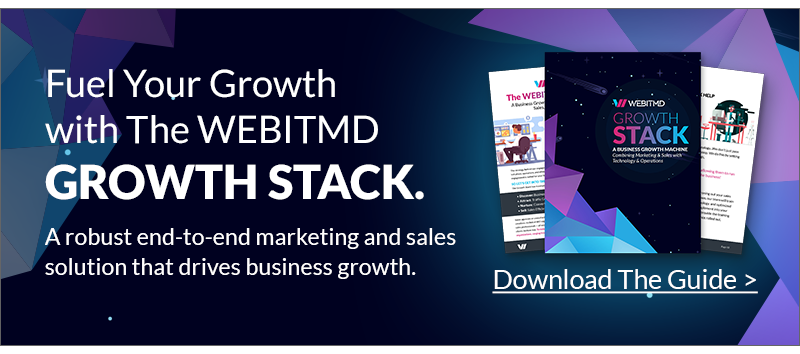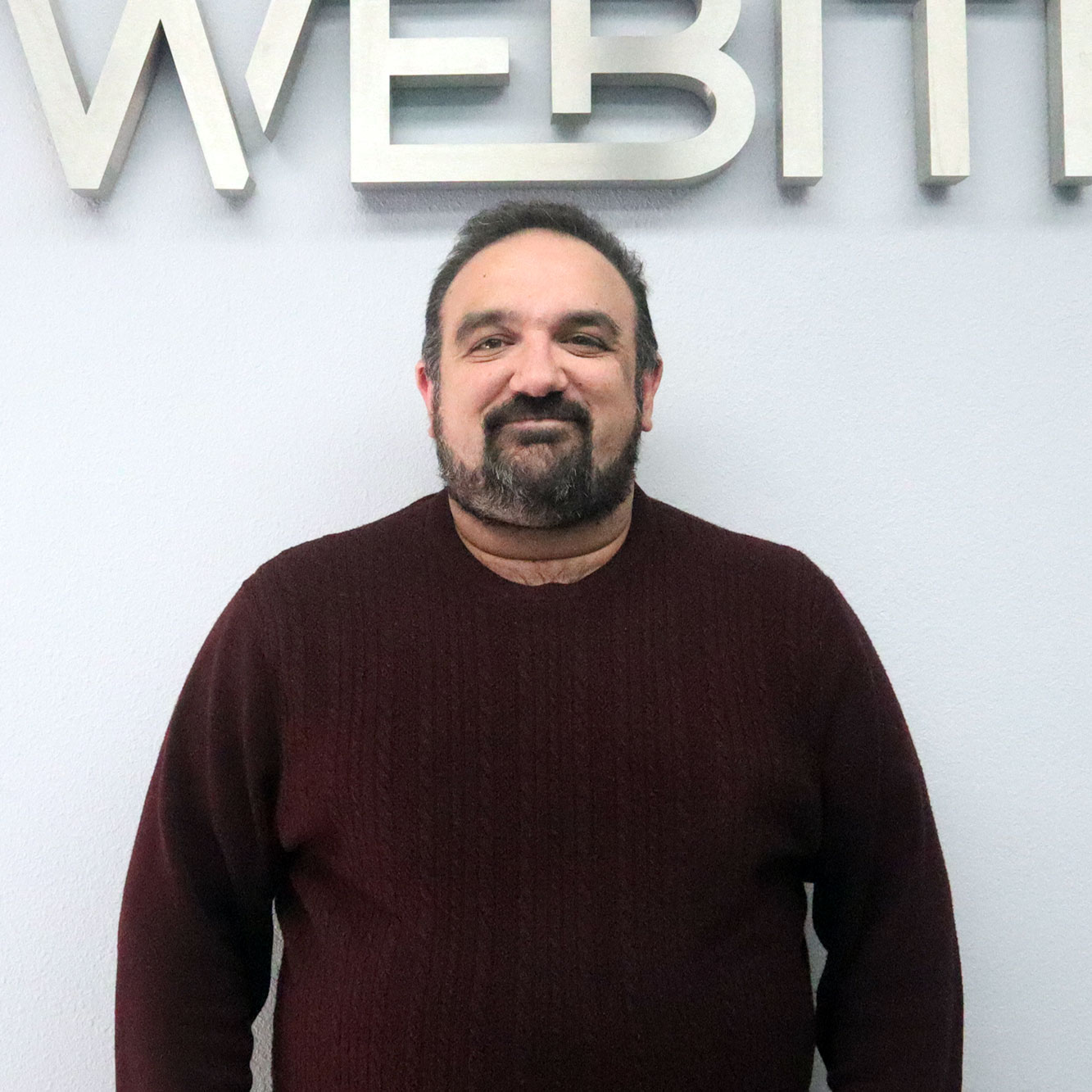Our CEO, Mattan Danino was invited to participate in a new podcast by performance-driven Marketing experts Symphonic Digital. The podcast was aired on July 28th and it focused on how to measure marketing success through the use of specific digital marketing tools and techniques. Mattan also gave a brief introduction to his career and the beginnings of WEBITMD.
“Mattan Danino, CEO of WEBITMD, sees a gap in digital marketing services”, said Steffen Horst, CEO & CO-Founder of Symphonic Digital, at the moment of introducing Mattan and the podcast in general, and continued saying: “he says that (he) helps bridge the gap between the theory of what should work… and what’s actually working”.
What’s ‘actually working’ can be listed as:
- Using KPIs to measure digital marketing results
- Integrating inbound marketing and sales
- Choosing the right attribution model
- The proper use of CRM
Among other useful insights, Mattan shared on the Podcast.
Measuring Marketing Campaigns Through Technology
Symphonic Digital’s podcast was a great opportunity for Mattan to provide his insight on the use of technology in measuring marketing campaigns. CRMs and other advanced automation tools can provide very specific data to use in what Mattan described as “tactical chess moves”; rather than just reporting on what’s working and what’s not:
“Understanding the customer is critical here. And the value of that customer all the way through that journey is really what technology allows us to do. And so those KPIs, as far as I’m concerned, are about business growth. But whether it’s a closed deal that takes six months from start to finish, if you will, B2B, or if it’s a one time check out of a T-shirt; nonetheless, the KPIs that we would measure in the marketing side all translate into becoming revenue downstream”.
Marketing Campaigns During COVID-19
Aside from the technical information per-se, Mattan also shared his thoughts on how such technology applies to 2020’s landscape; more specifically the COVID-19 situation. Even though there is a re-opening and there’s no longer a stay-at-home order in place, businesses are still trying to recover after the lockdown and they are relying on automation now more than ever. On this instance, Mattan was categoric:
“People are getting comfortable working remotely, buying more online. Even mid or enterprise-level deals with some of our clients, we’re seeing right now they’re closing over Zoom meetings. That wouldn’t have happened pre-COVID and I don’t think that’s the worst thing ever (…) they’re replacing people with technology like crazy. And they’re letting the tech do the work while keeping smaller teams on board to manage it. And so I think it’s here to stay and I believe the efficiency is evident”.
We hope you enjoyed this podcast! Thank you very much to Steffen Horst and the team at Symphonic Digital for this invitation to share knowledge with you! It was both a pleasure and an honor.
You can listen to some of our latest podcasts here:
WEBITMD Podcast with Don Burdge from My Company Story
Podcast “SEO On-Air: Content Marketing Hacks For E-commerce Stores to Boost Sales”
We also want to invite you to learn more about WEBITMD’s Growth Stack, a robust end-to-end sales and marketing solution that encompasses SEO, paid media, social media, content marketing, and many other solutions with inbound marketing and sales enablement. That way, you get full guidance all the way around the sales process for optimal, enduring results. Download WEBITMD’s free guide and learn how to transform your business.

Podcast Transcription
Steffen Horst: Welcome to the Performance Delivered Insider Secrets for Digital Marketing Success Podcast where we talk with marketing and agency executives and learn how they build successful businesses and personal brands. I’m your host, Steffen Horst. Today we’re going to talk about how to use technology to better measure success across marketing. Here to speak with me about the topic is Mattan Danino, who is the founder and CEO of WEBITMD, a growth marketing and sales enablement agency with offices in Los Angeles, New York City, and Dallas. Mattan, welcome to the show.
Mattan Danino: Yeah, thanks for having me.
Steffen: Mattan, before we dive deeper into today’s topic, let’s talk a little bit about yourself. Tell the listeners a little bit more about yourself.
The Inception of WEBITMD
Mattan: Sure. Yeah, sure thing. So I’m originally here from Los Angeles. I’m based here now. Did some undergraduate education down in San Diego, San Diego State that is, and just right out of school actually decided to launch this agency WEBITMD in 2008. At the same time, as you can imagine, just in a start-up, you know, myself, kind of as a one-man show. Still worked kind of in the marketing world on the hospitality side. Worked for Hyatt Hotels, doing a lot of internal digital and management, and also worked for a big data company down in San Diego.
But was launching the agency in 2008. And for the first three or four years, really focused on kind of the more tactical SEO, paid media, social, you know, and driving traffic, if you will. Built and grew the agency for the last 12 years. Here we are in 2020. And as you mentioned, I have three offices across LA, Dallas in New York City. We’re 10 of us on the team, so still pretty boutique in size. And we’re really focused now as a group on kind of two buckets of offering, or two buckets, I should say. focused, either b2b, traditional lead generation, or direct-to-consumer eCommerce.
Steffen: Okay, great. Well, what made it interesting to you to found your own agency? Why did you not stay with kind of the likes of Hired or the data company and explore an opportunity or a career there?
Mattan: Yeah, I mean, there’s the entrepreneurial spirit, of course, that many of us have. But beyond just that, I actually felt that there was a void in that kind of small-medium sector. So there were really good freelancers, kind of one-off groups. And then there was some at the time, pretty large-sized, you know, enterprise agencies who were working with, you know, the biggest of the brands, I think there was a gap and arguably still is, for agencies that focus in like true, small-medium, or call it even small business with two to 20 million in revenue, maybe even two to 50 million in revenue.
You know, like 10 to 50 person teams. I mean, there was just, there wasn’t a solid, like, agency environment, if you will, that I think focused on that. And I just wanted to come in and kind of deliver value there. So at the time, there was a little bit more of a wild west when it came to SEO, and arguably, that was easier than it is now in, you know, eight or nine to 10. Paid media as well, and at the time was much easier to drive results. So there’s this clear opportunity there, entrepreneurial-wise. I wanted to go for it. And it was somewhat a poster session if you will. After 08, 09 a lot of good businesses that came out of that time, I feel we’re a part of that wave.
Steffen: It’s about, you know, how to measure marketing campaigns, specifically how to use technology to better measure, you know, the results in activities across marketing campaigns. So from your perspective, why is it important to get a clear picture of not only individual marketing channels but also activities across marketing channels?
Using Technology to Measure Marketing Campaigns
Mattan: Yeah, I mean, I think it’s critical. So it’s really what you’re connecting here is what marketers do with what sales teams do, traditionally how that rolls up to leadership. There’s just no way you can track the efforts of a campaign and how effective it is without the use of technology. Now, these days, everything from a basic CRM to more advanced automation tools or attribution reporting, they can get, you know, very granular.
But the point is, technology does the work for us and allows us to, like understand those kinds of tactical chess moves, if you will, that all these different departments make and have it be in some type of high level, if you will, reporting that’s based on some data. Like, not just a theory of what’s working and what’s not. So I don’t think we need to work that hard to do that. Technology does it for us. And it really provides the kind of that bottom line type data that everyone’s really asking about.
Steffen: If we look at a funnel and even individual channels, it’s hard to have one KPI. I mean, at the end of the day, you know, if you have a b2b campaign, you’re probably looking after a max number of leads that convert to a sale, which obviously, the sales part of your client will have to take care of.
If you work with a b2c client, you know, you’re looking at a max number of revenue, for example. But with different channels, there are different KPIs that determine how they perform. Can you talk a little bit about how you would approach optimizing everything towards one goal, but then individually look at the performance for each individual channel? Does that make sense?
Mattan: It does. I mean, I think you described two buckets that I originally mentioned we focus on. And that are, those are two wildly different objectives. Both of them are to increase revenue, sure. But b2b wise versus you know, direct to consumer ecomm, widely different. I think what’s important though, is that the individual channels as you described, whether it’s organic search, or paid or social media traffic, like those are all marketing kind of efforts that drive-in, that bring awareness to a business, ultimately drive traffic, and get people, let’s just say, poking around a site.
Could be b2b or an eCommerce site. It’s the step after that and looking at what happens post traffic generation, the experience on the website. And then in the b2b setting, are people downloading some type of material or collateral that would kind of further educate them so they could build some interest? And on the direct-to-consumer side, are they poking around collections and product pages?
And are they adding stuff to the cart but then leaving? I mean, these are the actions that I think need to be reported on. And then all the way through revenue, again, b2b-wise, is it a proper sales opportunity? What does the sales process look like? How does the sales team traditionally go through the different stages, if you will, of the, you know, exploratory, and the qualification and the proposal, right? Eventually becoming a closed deal. On the ecomm front, it’s them actually checking out.
And so understanding the customer is critical here. And the value of that customer all the way through that journey is really what technology allows us to do. And so those KPIs, as far as I’m concerned, are about business growth. But whether it’s a closed deal that takes, you know, six months, you know, from start to finish, if you will, b2b, or if it’s a one-time check out of a T-shirt. Nonetheless, the KPIs that we would measure on the marketing side all translate into becoming revenue downstream.
Steffen: So the challenge I would see is that obviously, when you run, let’s say you run a programmatic advertising campaign, right? Or a display campaign, that obviously is more upper-mid funnel marketing, right? They don’t know you, you kind of expose some ads and hope that, you know, the ad is intriguing enough for someone to engage with the ad. While when you do paid search, for example, or remarketing or retargeting. That’s more lower funnel, so out of that probably comes more a lead or a sale. So what are different KPIs that you think people should measure depending on where the activity is in the funnel?
KPIs to Measure in a Marketing Funnel
Mattan: Yep, great question. So, from the top down, I think initially, you’re trying to drive traffic to bring awareness to the business. And so you want to look at what are people engaging with and doing on the site? How many pages are they viewing on the site, one? How much time are they spending on the site? Are they taking action? Doesn’t have to be a closing type action, like a sales-type action for a Contact Us page or an add to cart, but an action that could be a mid-funnel type action.
Are they interested in potentially giving their email and downloading content or joining a newsletter? Those are all things that we would measure and even assign points with technology to say, Well this has a value at this stage. As those kinds of add up and you monitor those, technology again, allows you to do that, the tools can then kind of give notice if you will to marketing teams and or salespeople that okay, this prospect or this potential customer is taking the actions that we need to go then and follow up with.
So it solves those problems of trying to figure out where to attribute your time if you will. So as I look at things like attribution, people normally go to a kind of what are the KPIs for attribution? But I also think about where should you kind of attribute your time? And what should people be spending time doing? They should be spending time doing the most important things based on people’s actions on a website.
Steffen: Just mentioned attribution. That’s obviously, a way of looking at data and in different channels that allows you to not only, and this is still very common in our industry, to look at the last click as the determining factor, but to find a different balance between all the channels to identify which channel has the greatest impact on the end goal, whether that is generating leads or a sale or generating revenue. How can attribution help with that? And what kind of attribution models are out there that people can or should consider?
Choosing the Right Attribution Model
Mattan: Yeah, attribution is a big topic because people want to know what was the final thing that actually contributed to the sale, most commonly known as last-touch attribution? But the first touch model also gives full credit to the touchpoints that actually drove a visitor to your website for the first time, regardless of their final outcome. And so I think that model, first touch, focuses on kind of the beginning of the journey.
And like, most of the time works for marketers who are specifically concerned with like, lead forms or demand generation, if you will. The last touch gives full credit only at the end. So if they make a purchase, and this is focused on the end of the customer journey. I mean, I think both of these should be set up. Sometimes businesses actually look up, excuse me, they look at somewhat of a combined attribution to give credit, if you will, like as a lead conversion or what’s called linear attribution.
There’s also time decay attribution. I can explain these if you’d like, but I think what’s important is the attribution has to assign credits, as I call them, to the actions that people are taking. If somebody’s going to click on an ad and they’re going to convert the first time to land on your site, well, fantastic, of course. But the chances of that happening, I would say is rather low, especially in the b2b world. They’re going to click around, they’re going to do their homework until finally, they do what I call convert, and that’s the first time they actually elect to give you their information. That to me is not a conversion.
Conversion actually is converting into some type of revenue-based, you know, transaction. And so that might be many clicks and many touchpoints down the road. So I think it’s super important to consider different models of attribution, you know, for your business, but not just stick to one. And we’ve had many clients that only say, Well, if they don’t click the first time and end up filling out a form, well, then we’re going to give credit to the second click or the third click. I think all of it plays a part in what ultimately is emerging.
Steffen: Interesting. Are you saying people should at least look at, you know, first click attribution and last-click attribution?
Mattan: Yeah, at a minimum. I think those are the most common which is it first touch or last touch? But I think there’s other models that are based on position. You can build even a custom model for yourself. And to give an example that, you know, like I said, if someone clicks on a paid search ad and then converts on the first visit, that’s amazing. But if they come from paid search and then they read an organic blog post, then they leave two days later and click on a remarketing ad.
They come back. And who do you give the credit to? So marketers and salespeople would typically kind of argue, if you will, well, they clicked on an ad and they converted. Well, no, they originally found out about your business from that first paid search click. And so I actually would probably split up that attribution and give a shared weight between let’s say, the display retargeting ad and the search first click.
Steffen: I would assume that attribution, or the best attribution model is different for different companies, right? The most cost-efficient system, let’s use that word, that companies can use. It doesn’t cost you anything, can be implemented easily and they have preset certain attribution models, basically.
And you can click between them and see what the impact is. From your knowledge, are there any systems available that automatically determine the best attribution approach? So for example, it could mean that the first click gets 30%, the second one gets 5%. And then as you work towards the final conversion point, it kind of increases in value. Is there something in the market that you’ve seen that you would recommend to the listeners out there?
Mattan: Yeah, great question. I mean, I know at an enterprise level we’ve used this tool called C3, C3 Metrics. And they help with like attribution, like an, I guess they’re very vertical-specific. We worked with them for ecomm. But we commonly use the tools that are like the most common of tools. Google Analytics, CRM tools, HubSpot, you know, Salesforce, and so on.
And we use these tools because we want to see the journey of the customer or the prospect at that point. And so it doesn’t, we’re not necessarily coming in and assigning a weight like you described percentage-wise. But what you could do is you could see, okay, what was the first click? What was the journey that they took? And then when you go to actually tag that opportunity, as let’s say, a closed deal, that’s one, or if they eventually check out at the cart and complete the transaction, you can come in there and then you can assign weight accordingly.
So you could build a model, where you assign weight to say, Okay, if the first click was paid search in my example, the last click was a remarketing ad, do 50/50 split. I think that should be determined on the client-side, let’s say, the business itself, as to, you know, how to make that kind of that split, if you will, because some businesses wouldn’t really want to do that. They would still want to give the weight to the first or the last touch.
Steffen: Yeah. And obviously and, you know, we’re quite deep into attribution at the moment. But the reason why this is important is just as an example, if you go for last-click attribution, it looks as if, you know, let’s say paid search and retargeting, which are the channels that usually generate conversions.
They’re doing all the heavy lifting and things like display advertising your content, new email marketing, potentially. And other channels might not drive any conversions, which means on a last-click model, he would probably say, ‘Well, you know what? It looks like they don’t add any value at the end’. Okay, so why are we doing this?
Mattan: I agree.
Steffen: Right? It looks as if the upper funnel solutions like display, you know, some Facebook prospecting etc. do all the heavy lifting and then paid search and retargeting literally doesn’t show any conversions in that regards, or very limited numbers of conversions. And both of these solutions are not ideal because you will discredit, so to speak, certain channels depending on what you use. So, therefore, looking across how each channel is impacting the overall goal is very important.
As we just talked about, I don’t think there is an ideal system for the general business out there to use that helps you and guides you to identify what is the best, you know, best weighting between the channels. But I think, you know, Mattan, what you said you should probably at least look at the last and then the first click to kind of get a feeling for everything. That’s something, you know, every business should do, or the agency or the individual that business hired to manage the digital marketing.
Mattan: Surely. Yes. I mean, the last touch, which you described, I think well, means that you’re solely focused on driving conversions and don’t value all those non-converting factors that happened prior. So that’s fundamentally flawed. But on the flip side, you know, the first touch has the same problem. Just on the other side of the spectrum.
So like, looking at lead conversions in general and what are a, what are the attributes, if you will and the touchpoints that ultimately generated leads and that model assigns credit to touchpoints where it was generated and along its journey. I mean, that’s more important and that’s something I think like you said, has to be determined either in house or by an agency to help, but it needs to be given weight across the, you know, across the different touchpoints not just first or last.
Steffen: Yeah. So Mattan, you earlier said you obviously b2bs is a big chunk of your business, right? Which quite often means, you know, the end goal, what you have control over is generating a lead through digital marketing activities. But then the sale happens on the client-side after marketing qualifies a lead, and sales qualified lead, and at least an end up on a desk of a salesperson, that person starts to reach out. How can attribution help to improve media investment in an area where you have limited control over?
Using Attribution to Influence Areas Where You Otherwise Have Limited Control
Mattan: Sure. Yeah, so one thing that we’ve done, and this is a change you made as of about three or four years ago now, but for the first eight years since inception, we were really looked at as a vendor of services, which put us in a place to do, like you said, the driving traffic pieces, SEO, paid media, social writing, content, marketing, etc.
And where our engagement ended, and where we ended off kind of the baton, if you will, to the in house team, our clients, would be to take it from there as a marketing qualified lead and hopefully do their part of the deal, which would be to, you know, educate and do the sales process and hopefully close the deal. Whether they were good at doing that or not, we hope that they would do that.
And if they did do that, then everyone wins and we get shared credit. When that didn’t happen, we had no kind of visibility into their process, but surely we would be the ones with the finger-pointing as if, you know, well, it must be marketing that’s not generating good leads. So that was something that we changed three or four years ago, developed an offering we call the growth stack, which essentially drives people through a whole funnel of traffic, the middle of the funnel experience on the website, traditionally, inbound marketing or nurturing and automation.
And then working closely with sales teams and actually building outsales processes and then looking at sales automation, using technology. Like, these are the pieces that we wanted to get our hands into, almost out of sheer need. But we wanted to get our hands into it because we wanted to ensure that all that we were doing upstream, if you will, marketing-wise was translating into revenue. So that’s been huge.
Steffen: Yeah. Mattan, talk a little bit more about that. How do you hold the sales team that is not employed by you, right? That’s employed by your client. To a certain level, accountable to not only in a timely fashion follow up or engage with the leads, but also provide your feedback because, you know, as the agency at the end of the day that does the media investment needs to identify which messaging works, which channel works, you want to get feedback on did lead A that came from search or have a certain message is better than lead B that came from LinkedIn with another message, for example.
Mattan: That’s right. Yeah, no, that’s right. I mean, that’s the bottom line, what everyone cares about. So we make it a point that not only do we care about that, but we want to help facilitate, you know, that whole process, if you will, and we do that with the use of technology. And so to the point here around how do we use technology across marketing campaigns, I would stretch that to marketing and sales.
We almost, I don’t want to say we forced it, but we ensure that there is some tech in place that would allow us to take opportunities from the part that we do and we’re absolutely accountable for driving traffic awareness and all of that top-funnel, but driving it into a proper piece of technology, traditionally a CRM or some type of marketing automation tool, and then through a sales process, making sure that the tagging and the drill-downs and attribution is correct.
And then finally, when that opportunity becomes a closed deal, we want to know well, where did that come from? And then we talked about different ways to kind of market and attribution lines, but where did that deal come from? So we want to know what marketing activity channel etc, actually became a piece of dollars. And, of course, that’s what our clients want as well. So that’s a huge part of what we do. And that’s really allowed us to change this kind of narrative, if you will, from being like a vendor to being like a true partner with our clients.
Steffen: Mm-hmm So you just mentioned a CRM system, obviously. Would you use that as your central hub to collect all data for an organization? And if so, why do you think companies need to think about that and should have a system in place?
Mattan: I think it’s critical. I think without that, I don’t know how you could be flying blind with just looking at these anonymous reports, even Google Analytics, the most industry-standard tool, it takes traffic visitors, you know, time on site and all these numbers, if you will, and ends up, the final kind of end of the road for Google Analytics is a conversion. That conversion, whether it’s one or 70, or 700, is an anonymous conversion.
You don’t know who that person is. Now, the CRM allows you to actually say, well, that one conversion that happened, you know, today this afternoon is Mr. John Doe. And then you can have all the reporting on John Doe, what’s his activity on the website? So to me, the CRM that houses that information, and then of course, contracts, you know, web activity and so on with cookies. And that, without that, I don’t know how you’re running, you know, a business in 2020. I think you have to have a central hub. Yes.
Steffen: Yeah. So we talked about this from a sales perspective. Does the same apply for an ecommerce company?
Mattan: I think so, yeah. Ecomm is a little different, right? Because the experience ends for at least as he comes concerned, the first sale ends when they actually add to cart and checkout. But I think that’s half the battle. With ecommerce, I think still having a CRM, still having a proper email tool and marketing automation tool, everything that’s done post-sale is where most ecommerce companies actually break-even and start to make money.
Many don’t make money on the first sale, but they assume that you’re going to come back a second or third time, you’re going to click in an email to refer a friend with some type of coupon code. I mean, that’s critical in order to be successful. So similarly, all that needs to be housed in a central place.
Steffen: So getting back to a more higher level, how do you see technology playing a part in this current climate? Like when we record this at the moment, we’re still in COVID-19 situation. We’re no longer in shelter, things are opening up again but businesses, they either still struggle or they’re trying to recover from being closed down for the last two, three months.
Mattan: Sure. Yeah, no, I think this was a wake-up call for those businesses, ones that were living on, you know, Google spreadsheets, or even worse, that, you know, spreadsheets that are on someone’s physical machine. I mean, they woke up and they realized, alright, we need to be doing more in the digital space. Our trade shows got canceled, our conferences are not happening this year, we need to be doing things.
And the way that they’re doing things more digitally, you know, selling over Zoom and tech that played into a proper CRM and chatbots and like things that could drive efficiency and automation for a business now, it’s critical. I don’t think it’s going anywhere. Some folks, you know, believe that they will go back to the office and, you know, work once again with people. Sure, absolutely. But I think less human interaction and more technology is here to stay.
And so people are getting comfortable working remotely, buying more online, you know, mid even mid or enterprise-level deals with some of our clients, we’re seeing right now they’re closing over Zoom meetings. That wouldn’t have happened pre-COVID and I don’t think that’s, you know, that’s the worst thing ever. I believe that they detect pieces like bots, or some type of AI tools for sales. All those play a part in technology kind of driving us forward, you know, versus humans doing things.
Yeah, I mean, I really see that being the case, both from startups through enterprises. Small startups have to be more nimble. I mean, now they’re more than ever, every dollar that they spend. And so they rely on tech to kind of power their marketing and sales campaigns. They need to get more out of the small teams that they are, for larger companies, to some extent, similarly. You know, they’re replacing people with technology like crazy. And they’re letting the tech do the work while keeping smaller teams on board to manage it. And so I think it’s here to stay and I believe the efficiency is evident.
Steffen: Mattan, I think that’s a great final point. Thank you so much for joining me on the Performance Delivered Podcast and sharing your thoughts and knowledge about how companies can use technology to better measure success across marketing campaigns and why it is important to do so. If people want to find out more about yourself, about your company, how can they get in touch?
Mattan: Sure, yeah. Thanks for having me. It was always a great good conversation. And WEBITMD is the name of our agency. It’s Web IT MD just webitmd.com. They can check out the site and there’s lots of great information there. We just launched a new resource hub, I should say, lately, that really has a lot of good information, podcasts, blogs, articles, and so on. They can reach out to me as well, just my first name mattan@webitmd.com. It’s MATTAN. Happy to always, you know, strike up conversations with other industry peers, and otherwise, we all keep growing together.
Steffen: Great. Well, thanks, everyone for listening. If you like the Performance Delivered Podcast, please subscribe to us and leave us a review on iTunes or your favorite podcast application. If you want to find out more about Symphonic Digital, you can visit us at symphonicdigital.com or follow us on Twitter at Symphonic HQ. Thanks again and see you next time.







(1).jpg)

.jpg)



![5 Reports to Elevate Your HubSpot Sales Dashboard [+ Examples]](https://2363531.fs1.hubspotusercontent-na1.net/hub/2363531/hubfs/Imported_Blog_Media/6-winning-examples-of-a-hubspot-sales-dashboard-2.png?width=767&name=6-winning-examples-of-a-hubspot-sales-dashboard-2.png)

